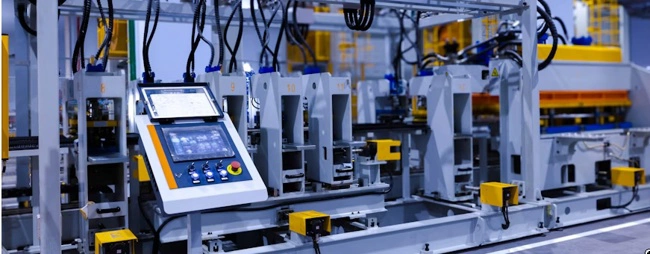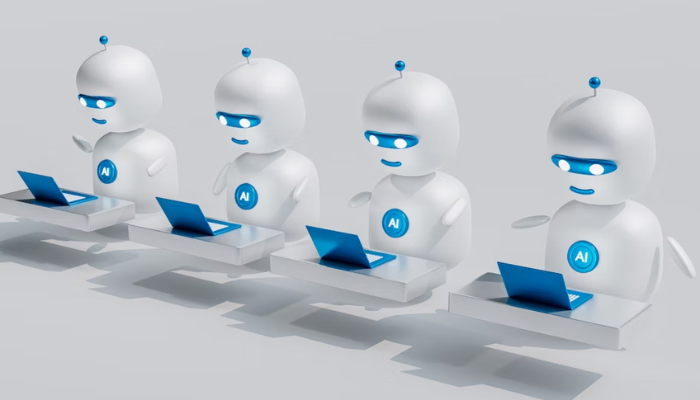How the Future of Automation will Transform Business
From self-driving cars to intelligent virtual assistants, automation is no longer a futuristic concept but a rapidly unfolding reality. Businesses, in particular, are at the vanguard of this transformation, with automation promising to redefine operational paradigms, enhance efficiency, and unlock unprecedented growth opportunities. Understanding the trajectory and implications of this shift is paramount for any enterprise aiming to remain competitive and relevant in the evolving global landscape.
The future of automation is poised to fundamentally transform business operations, impacting everything from customer service and supply chains to human resources and strategic decision-making. We'll explore how advanced technologies like Artificial Intelligence (AI), Machine Learning (ML), and Robotic Process Automation (RPA) are not just streamlining existing tasks but creating entirely new avenues for innovation and value creation. This evolution will necessitate a significant reimagining of workforce roles, demanding new skill sets and a collaborative approach between human intelligence and automated systems.
This in-depth article will delve into the multifaceted ways automation will reshape the business world. We will explore the key technologies driving this revolution, the profound benefits businesses stand to gain, and the significant challenges that must be navigated. Furthermore, we will examine the societal and ethical implications, including the evolving nature of work, and provide actionable strategies for businesses to strategically embrace automation for sustainable success. Read on to discover how your business can thrive in the automated processes.
How the Future of Automation Will Transform Business [Key Automation Technologies]
The transformative power of automation systems comes from a confluence of sophisticated technologies, each contributing unique capabilities to the overall ecosystem. Understanding these core components is essential to grasping the breadth of automation's impact.

Artificial Intelligence (AI) and Machine Learning (ML)
At the heart of advanced automation lies Artificial Intelligence (AI) and its subset, Machine Learning (ML). AI empowers machines to simulate human-like intelligence, performing tasks that typically require human cognitive abilities, such as problem-solving, learning, and decision-making. ML, on the other hand, provides AI systems with the ability to learn from data without explicit programming.
- Predictive Analytics: AI and ML algorithms can analyze vast datasets to identify patterns and predict future outcomes. This is invaluable for demand forecasting, risk assessment, and proactive maintenance, allowing businesses to make more informed decisions. For instance, in manufacturing, AI-powered predictive maintenance can detect potential equipment failures, reducing costly downtime.
- Enhanced Decision-Making: By processing and interpreting complex data at speeds impossible for humans, AI can provide real-time insights that bolster strategic decision-making. This extends to areas like financial trading, where AI algorithms can analyze market trends and execute trades with remarkable speed and precision.
- Personalization and Customer Insights: AI drives hyper-personalization in customer interactions, from tailored product recommendations to dynamic email marketing campaigns. This deep understanding of customer behavior enhances engagement and conversion rates.
Robotic Process Automation (RPA)
RPA utilizes software "bots" to automate repetitive, rule-based tasks that typically involve human interaction with digital systems. Unlike physical robots, RPA operates at the user interface level, mimicking human actions like clicking, typing, and data entry.
- Automating Repetitive Tasks: RPA excels at automating high-volume, monotonous tasks such as data entry, invoice processing, customer service inquiries (through chatbots), and report generation. This significantly reduces human error and frees up employees for more strategic work.
- Improved Efficiency and Accuracy: Bots can work 24/7 without fatigue or errors, leading to substantial improvements in processing speed and data accuracy. This translates to faster turnaround times and reduced operational costs.
- Scalability: RPA solutions are highly scalable, allowing businesses to handle increased workloads without necessarily hiring more staff. This adaptability is crucial in dynamic market environments.
Intelligent Automation (IA) and Hyperautomation
Intelligent Automation (IA) represents the convergence of RPA with AI and ML, enabling automation of more complex, unstructured tasks that require cognitive abilities. Building on this, hyperautomation takes a holistic approach, aiming to automate as many business processes as possible across an organization using a combination of technologies.
- End-to-End Process Optimization: IA can streamline entire workflows, from data intake and processing to decision-making and execution, creating seamless automated journeys.
- Handling Unstructured Data: Unlike traditional RPA, IA can interpret and process unstructured data (e.g., text, images, voice), expanding the scope of automation significantly. This is critical for tasks like sentiment analysis in customer feedback or intelligent document processing.
- Strategic Prioritization: By 2026, around 90% of major corporations are expected to list hyperautomation as a strategic priority, recognizing its potential for comprehensive operational optimization.
Internet of Things (IoT)
The Internet of Things (IoT) refers to the network of physical objects embedded with sensors, software, and other technologies that allow them to connect and exchange data with other devices and systems over the internet.
- Real-time Data for Automation: IoT sensors provide a constant stream of real-time data, which can feed into AI and automation systems for enhanced monitoring, control, and decision-making.
- Smart Manufacturing: In manufacturing, IoT enables smart factories where machines, products, and systems are interconnected, allowing for optimized production lines, predictive maintenance, and improved quality control.
- Supply Chain Optimization: IoT devices can track goods throughout the supply chain, providing real-time visibility into inventory levels, shipping conditions, and delivery status, enabling more efficient and automated logistics.
The Transformative Benefits of Automation for Businesses
The adoption of automation is not merely a trend; it's a strategic imperative offering a myriad of advantages that fundamentally redefine how businesses operate and compete.

Enhanced Efficiency and Productivity
Perhaps the most immediate and tangible benefit of automation is the dramatic increase in efficiency and productivity. Automated systems can perform tasks at speeds and scales unattainable by human workers, working 24/7 without breaks, fatigue, or diminishing returns.
Routine tasks that once took hours or days can be completed in minutes or seconds. Manufacturing lines with robotic automation can produce goods at a much higher volume and consistent rate. Automation removes manual bottlenecks, allowing workflows to move more smoothly and rapidly.
Significant Cost Reduction
While initial investments in automation technology can be substantial, the long-term cost savings are often immense.
Lower Labor Costs: Automation reduces the need for manual labor for repetitive tasks, leading to decreased payroll expenses.
Minimized Errors and Rework: Automated processes are less prone to human error, cutting down on costly mistakes, rework, and associated penalties.
Optimized Resource Utilization: Automation can help businesses optimize the use of materials, energy, and other resources, leading to reduced waste and improved profitability.
Improved Accuracy and Quality
Machines follow predefined rules and logic with unwavering consistency, virtually eliminating human error in automated tasks. This leads to a marked improvement in accuracy and product/service quality.
Consistent Output: Every automated task is performed identically, ensuring a consistent level of quality across all outputs.
Compliance and Audit Trails: Automation can enforce strict adherence to regulatory guidelines and internal policies, automatically generating detailed audit trails for compliance purposes.
Enhanced Product Reliability: In manufacturing, precision robotics and automated quality control lead to more reliable and defect-free products.
Elevated Customer Experience (CX)
Automation plays a pivotal role in delivering superior customer experiences by enabling faster, more personalized, and consistent interactions.
AI-powered chatbots and virtual assistants can provide instant support and answer common queries around the clock, improving response times significantly. Automation leverages customer data to deliver highly personalized recommendations, communications, and support, fostering stronger customer relationships.
Automated systems can quickly process requests, resolve issues, and route complex queries to human agents, minimizing customer wait times and frustration. Automation ensures that every customer interaction, regardless of channel, adheres to predefined service standards, building trust and brand loyalty.
Data-Driven Decision Making
Automated systems generate vast amounts of data, which, when analyzed by AI and ML, provide invaluable insights for strategic decision-making. Businesses gain real-time visibility into their operations, allowing for immediate adjustments and optimizations.
Trend Identification and Predictive Analytics: Automation enables businesses to identify market trends, anticipate challenges, and proactively seize opportunities. Data-driven insights from automated processes help businesses allocate resources more effectively, maximizing ROI.
Scalability and Flexibility
Automation provides businesses with the agility to scale operations up or down rapidly in response to changing market demands.
- Adapting to Demand Fluctuations
- Seamless Integration
- Rapid Deployment of New Processes
Strategic Implementation for the Automated Future
To successfully navigate the future of automation and leverage its full potential, businesses need a well-defined strategy that goes beyond mere technological adoption.

Start with a Clear Vision and Objectives
Before embarking on any automation initiative, clearly define your goals. What specific business problems are you trying to solve? What outcomes do you hope to achieve (e.g., cost reduction, improved CX, increased innovation)?
- Identify High-Impact Areas: Begin by identifying processes that are repetitive, time-consuming, prone to error, or critical to business success and offer the highest potential ROI from automation.
- Pilot Projects: Start with small, manageable pilot projects to test the feasibility of automation, learn from early implementations, and demonstrate quick wins to build internal buy-in.
Invest in Workforce Development
Recognize that your employees are your most valuable asset in the automated future. Develop comprehensive training programs to equip your workforce with the skills needed to interact with, manage, and innovate with automated systems.
Encourage continuous learning and adaptability within your organization, as the technological landscape will continue to evolve rapidly. Proactively analyze how job roles will change and empower employees to transition into higher-value, more strategic positions.
Prioritize Data Governance and Cybersecurity
Robust data management and security are non-negotiable in an increasingly automated environment.
- Data Quality and Integrity: Ensure that the data feeding your automation systems is accurate, consistent, and reliable to prevent biased or erroneous outcomes.
- Comprehensive Cybersecurity Strategy: Implement a multi-layered cybersecurity approach to protect automated systems and sensitive data from threats.
- Compliance Frameworks: Establish clear frameworks to ensure all automated processes comply with relevant data privacy and industry regulations.
Embrace a Phased and Iterative Approach
Automation is not a one-time project but an ongoing journey.
- Modular Implementation: Break down large automation initiatives into smaller, manageable modules that can be implemented and refined iteratively.
- Continuous Monitoring and Optimization: Regularly assess the performance of automated processes, gather feedback, and make continuous improvements to optimize their effectiveness.
- Flexibility and Adaptability: Be prepared to adapt your automation strategy as technologies evolve and market conditions change.
Foster a Culture of Innovation and Collaboration
Successful automation requires a shift in organizational culture, promoting experimentation, cross-functional collaboration, and a willingness to embrace new ways of working.
- Cross-Functional Teams: Encourage collaboration between IT, business units, and employees to identify automation opportunities and ensure successful implementation.
- Empower Citizen Developers: Leverage low-code/no-code platforms to empower business users to develop their own automation solutions, accelerating adoption and innovation.
- Ethical Review Boards: Consider establishing ethical review boards for AI and automation initiatives to ensure responsible development and deployment.
Conclusion
The future of automation is not a distant fantasy but a present reality that is rapidly reshaping the contours of business. From boosting efficiency and reducing costs to elevating customer experiences and driving innovation, the transformative potential is immense. While challenges such as job displacement and cybersecurity concerns are real and require careful navigation, the strategic embrace of technologies like AI, ML, and RPA is no longer an option but a prerequisite for sustained success.
Businesses that proactively invest in workforce development, prioritize data governance, and adopt a flexible, iterative approach to automation will be best positioned to thrive. By understanding the intricate interplay between human ingenuity and technological capability, organizations can forge a future where automation serves as a powerful catalyst for growth, competitiveness, and societal progress. The time to prepare for this automated future is now.
Ready to unlock the power of automation for your business? Begin by identifying a key repetitive process within your organization and explore how automation can streamline it, freeing up your team for more strategic endeavors. Contact Guru Solutions, a reputable automation solutions provider, today to discuss a tailored roadmap for your automated future!









